Intel Woodcrest: the Birth of a New King
by Jason Clark & Ross Whitehead on July 13, 2006 12:05 AM EST- Posted in
- IT Computing
Architecture Summary
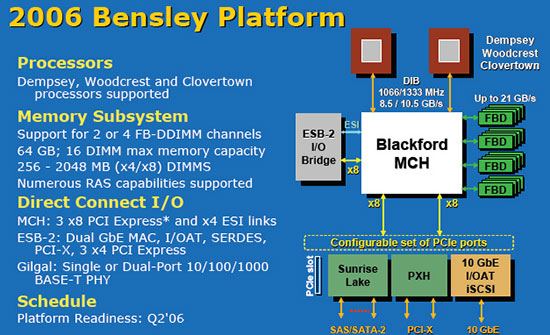
Woodcrest's home is a newer revision of the Bensley platform than what Dempsey launched with, which means that it's a drop-in part for newer Bensley based systems. If all goes to plan Clovertown (Quad-Core Xeon) should be a drop-in upgrade as well (depending on the system vendor). As we discussed in our Dempsey article, the Bensley platform features FB-DIMM with a peak bandwidth of 21GB/sec, SAS/SATA support and 1066/1333MHz FSB.
Woodcrest Highlights:
Shared 4MB L2 "Smart Cache"
Dempsey based processors had a separate 2MB L2 cache for each core, but Woodcrest has 4MB of L2 Cache shared between both cores. Due to the fact that the cores share a single cache, there is no data replication like there is with separate L2 caches; this results in more efficient data-sharing between cores. The shared cache also helps with mismatched loads: when one core is consistently using more cache than the other core, the CPU can allocate more L2 cache to that core. Both of these techniques are illustrated below.
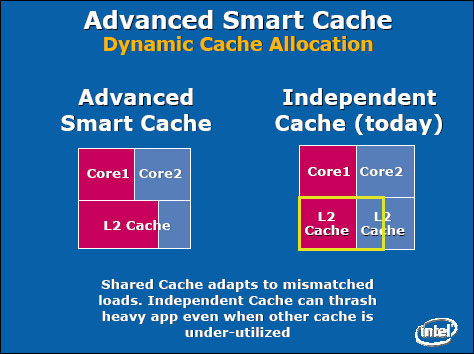
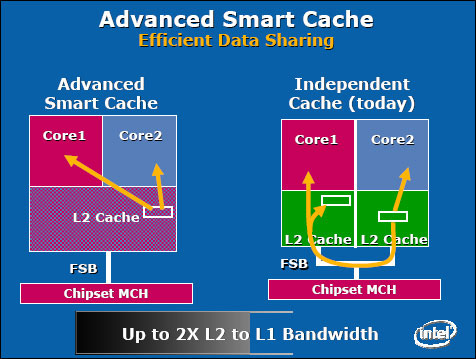
Wide Dynamic Execution Enhancements
With the Intel Core micro-architecture, every execution core is 33% wider than previous generations, allowing each core to fetch, dispatch, execute and retire up to four full instructions simultaneously. The Opteron - as well as all previous NetBurst Xeon processors - can only handle 3 at a time.
Macro Fusion
Macro-fusion combines certain common x86 instructions into a single instruction for execution. Without Macro-fusion four instructions at a time are fetched from the queue and each instruction gets decoded into separate micro-ops. With Macro Fusion, 5 instructions can be fetched at a time, and if a fusable pair is present it can be sent to a single decoder. A single micro-op can then represent two regular x86 instructions.
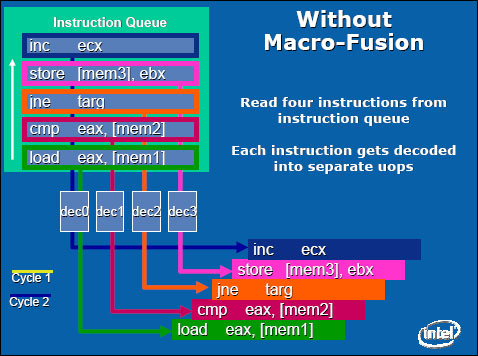
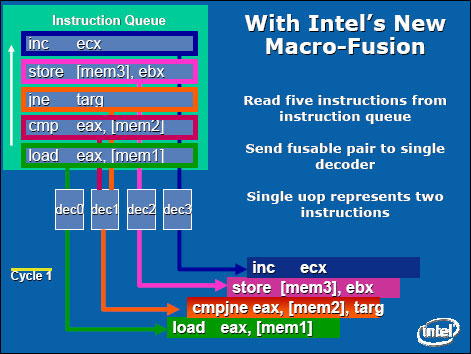
Beyond 2 Sockets, is Intel's FSB still an Achilles Heel?
As we've seen in past benchmarks, the front side bus has been a thorn in Intel's side, especially in the quad socket systems. Whether or not the new architectural changes that Intel has made with Woodcrest will alleviate enough of that pressure to overpower the scalability of Opteron in four socket configurations is unknown at this point. Intel is quite confident that with the shared cache and its dual independent FSB running at 1333MHz that bus bandwidth is not a concern, however at some point the bus bottleneck will be a problem. One of Intel's architects has however stated that an integrated memory controller is possible, which Intel has already shown us a demo of.

Woodcrest's home is a newer revision of the Bensley platform than what Dempsey launched with, which means that it's a drop-in part for newer Bensley based systems. If all goes to plan Clovertown (Quad-Core Xeon) should be a drop-in upgrade as well (depending on the system vendor). As we discussed in our Dempsey article, the Bensley platform features FB-DIMM with a peak bandwidth of 21GB/sec, SAS/SATA support and 1066/1333MHz FSB.
Woodcrest Highlights:
Shared 4MB L2 "Smart Cache"
Dempsey based processors had a separate 2MB L2 cache for each core, but Woodcrest has 4MB of L2 Cache shared between both cores. Due to the fact that the cores share a single cache, there is no data replication like there is with separate L2 caches; this results in more efficient data-sharing between cores. The shared cache also helps with mismatched loads: when one core is consistently using more cache than the other core, the CPU can allocate more L2 cache to that core. Both of these techniques are illustrated below.


Wide Dynamic Execution Enhancements
With the Intel Core micro-architecture, every execution core is 33% wider than previous generations, allowing each core to fetch, dispatch, execute and retire up to four full instructions simultaneously. The Opteron - as well as all previous NetBurst Xeon processors - can only handle 3 at a time.
Macro Fusion
Macro-fusion combines certain common x86 instructions into a single instruction for execution. Without Macro-fusion four instructions at a time are fetched from the queue and each instruction gets decoded into separate micro-ops. With Macro Fusion, 5 instructions can be fetched at a time, and if a fusable pair is present it can be sent to a single decoder. A single micro-op can then represent two regular x86 instructions.


Beyond 2 Sockets, is Intel's FSB still an Achilles Heel?
As we've seen in past benchmarks, the front side bus has been a thorn in Intel's side, especially in the quad socket systems. Whether or not the new architectural changes that Intel has made with Woodcrest will alleviate enough of that pressure to overpower the scalability of Opteron in four socket configurations is unknown at this point. Intel is quite confident that with the shared cache and its dual independent FSB running at 1333MHz that bus bandwidth is not a concern, however at some point the bus bottleneck will be a problem. One of Intel's architects has however stated that an integrated memory controller is possible, which Intel has already shown us a demo of.










59 Comments
View All Comments
bwmccann - Thursday, July 13, 2006 - link
It is about time to see some benchmarks on Woodcrest. This is a victory for Intel in the dual cpu server market. It will be interesting to see how much market share they will be able to take back since losing some to AMD last year. I'm also happy to see that Intel has a roadmap for the future and with their history i'm sure they will be able to produce results.However on the other hand AMD is not going to stand still. The Opteron is an amazing chip and still leads in servers with more then 4 CPUs. You can bet they are working hard to one up this release. Unfortunately they have to deal with Conroe coming out on the client side later this month and it could start to stretch AMD resources thin. I can't wait for the upcoming battle!!!
Calin - Thursday, July 13, 2006 - link
From now on, AMD will compete (in new servers) mostly on price (at least after the point Intel will be able to produce the new microprocessors in enough quantity). For existing installations, they could be able to sell new servers "like the existing ones".This is very bad news for AMD
bamacre - Thursday, July 13, 2006 - link
Go, Intel go!JackPack - Thursday, July 13, 2006 - link
Murder, AMD wrote.coldpower27 - Thursday, July 13, 2006 - link
:cheers: Yay Go Intel!!! Woot!! Amazing!!!duploxxx - Thursday, July 13, 2006 - link
lol, that's a nice comment you give. you probably didn't look so well at the real charts.Nice setup again, but comparing a 2,6 to 3,0 it is normal that a 3,0 will have the performance crown looking at the new architecture. however if you look at the performance gain from 2,4 to 2,6 on the opteron and recalculate it to 3,0 you will see almost equal performance. so your thread start "birth of the new king" is not so clear to mee. Yes you can state that intel will have a 3.0 and AMD not at the moment.... but ehhh where are the woodcrests at the moment in the field.... yes none, i only have Eng Samples and backorders till end-august. So this is a big paper launch.
one missing point in your article... you clearly define the setup here with decent systems but what i am missing is the amount of dimms used... calculating this in performance can give a difference up to 25watt = 10%.
i really want to see your follow up on the windows platform....
ruprecht - Thursday, July 13, 2006 - link
Of course many people are sad to see "plucky underdog" AMD be beaten by the Giant Intel, but this is really to be expected and, in fact, it's no bad thing.I say that for 2 reasons. First, new architectures are (generally) better than old ones and it's time for CPU technology to move a step ahead.
AMD has been king of the hill for about 2 years. That's quite a long time, and in that time K8 has really come to the end of it's life span (at least as a top of the range chip). So it's no surprise that the first really new architecture since K8 hit the scene is going to be a lot better than what we have at the moment.
There's really going to be nothing much that AMD can do in the single and dual-core arena to counter Core 2 until early next year at best. It sucks for AMD but that's life. They'll survive OK for a few months in second place.
Secondly, AMD needs the competition from Intel as much as Intel needs the competition from AMD. I have an FX51 box which I bought almost 3 years ago. The CPU runs at 2.2Ghz, it has 2GB of DDR 400 RAM and a pair of Raptors in a RAID 0 array. Despite being 3 years old it's still pretty fast.
My point here is that up until recently, if you were building a new AMD rig you would probably not have been buying a CPU or RAM that was a whole lot faster that what I have in my PC. So in almost 3 years AMD has only increased the speed of its processors incrementally. Although admittedly it did go dual core with much more success than Intel. AMD needs Intel to push it to do better. If they had K8L ready today, would they have lost the crown?
So AMD are now in second place, but it's going to be very interesting to see what happens in the next 6 months or so, and also let's enjoy the benefits that the new architecture(s) are going to bring to us all!
JackPack - Thursday, July 13, 2006 - link
1. Performance scaling is not linear. I'm not sure how you can determine Opteron 3.0 performance by looking at only 2.4 and 2.6.2. I guess you don't live in America? The ship dates are very reasonable. Not "end-august" as you suggest.
http://h71016.www7.hp.com/dstore/ctoBases.asp?Prod...">http://h71016.www7.hp.com/dstore/ctoBas...1&Fa...
duploxxx - Thursday, July 13, 2006 - link
wel you forgot to read the whole page.....HP is not responsible for delays outside of our immediate control, including delays related to order processing or unexpected increase in demand. Typically only orders paid for by credit card receive credit approval on the same day the order is placed. Orders delayed due to order processing will default to an Estimated Ship Date 30 days from the date credit is processed and the order is released. Estimated Ship Dates are based on any known extended lead times.
Accord99 - Thursday, July 13, 2006 - link
It says the same thing for their Opteron servers.Newegg has the 5150 Woodcrest for sale:
http://www.newegg.com/Product/Product.asp?Item=N82...">http://www.newegg.com/Product/Product.asp?Item=N82...